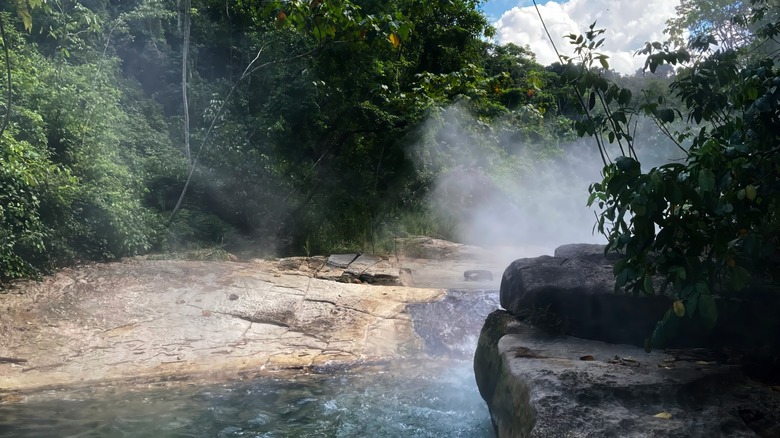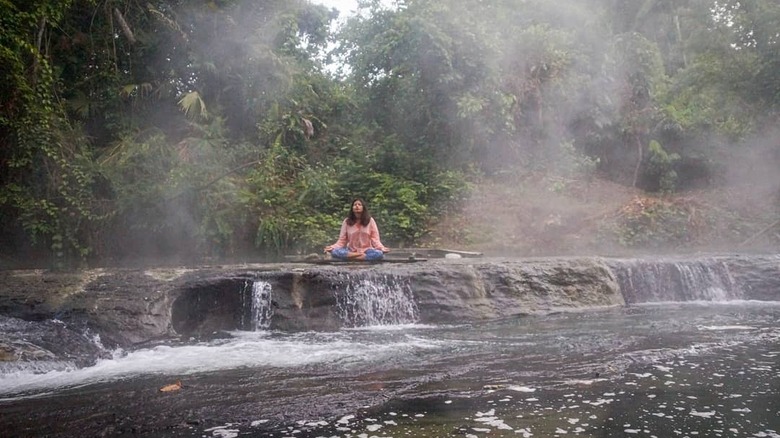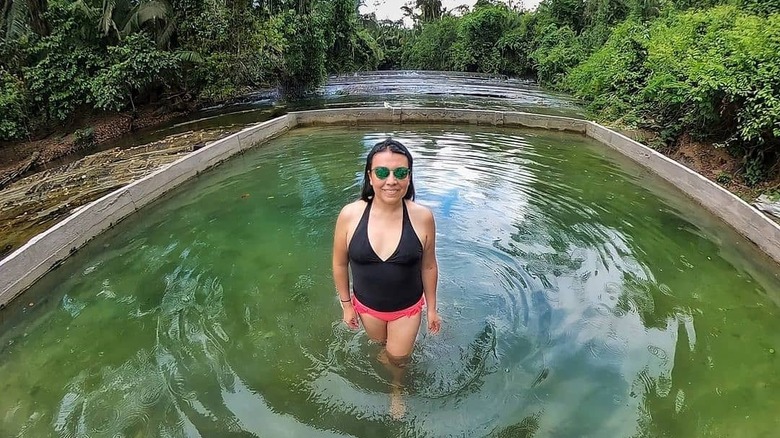This River Experiences A Horrifying Phenomenon That Makes It Uniquely Dangerous
For many of us, the Amazon rainforest still evokes images of danger and exotic adventure. British explorer Percy Fawcett vanished in the mid-1920s after years of obsessively searching for a lost city of gold deep in the rainforest, while Indiana Jones had slightly better luck at the beginning of "Raiders of the Lost Ark" before losing the loot to his archrival. The Amazon whispers tales of flesh-eating diseases, razor-toothed piranhas, incredible creepy crawlies, lost tribes, and the myth that a certain type of fish can swim up the flow of urine from someone careless enough to take a bathroom break in the water. Then you have the lesser-known hazard of Shanay-Timpishka, a river that runs almost hot enough to boil unwary swimmers alive.
Shanay-Timpishka, Peru's boiling river, wasn't studied scientifically until 2011 when Andrés Ruzo, an intrepid geoscientist, followed the myths he'd heard as a child into a remote part of the rainforest to see if the stories were true. After an arduous journey into the heart of the Peruvian Amazon, he found the source of the legends. There in the Mayantuyacu region, a local shaman's apprentice showed him a stretch of water almost four miles long that ran so hot that it could poach a small animal to death. So what exactly is the Boiling River, and is it possible to visit?
What causes the Amazon's Boiling River?
Shanay-Timpishka translates to "Boiled with the heat of the sun" in the local Asháninka dialect, and the first part of the name almost holds up. At its hottest, the water temperature reaches around 183 degrees Fahrenheit – not quite boiling, but certainly enough to cause serious injury. The region's shamans have long placed importance on the river's mythical powers, believing that it is home to Yacumama, a huge serpent spirit reputed to be 200 feet long and known as the "Mother of the Waters." Yet the true provenance of the Boiling River has nothing to do with giant snakes or the heat from our star.
The Boiling River is an important geothermal feature that is unusual because it is situated around 400 miles from the nearest volcano, which is usually the cause of thermal rivers. The current theory is that water in the area filters down through faults in the surface of the Earth and heats up the deeper it goes, then gets forced up through other cracks and fissures in the rock to create what is regarded as an "anomalously large" thermal river. The result is a stretch of water that is both culturally and scientifically significant; the Boiling River has been a sacred place for local Asháninka shamans, and experts like Andrés Ruzo are striving to save it from threats posed by deforestation in the Amazon.
Can you visit the Boiling River?
In the years since the official discovery of Peru's Boiling River, it has fallen under threat due to the ruthless exploitation of the Amazon's natural resources. Kelly McMillan of National Geographic described how when they first visited in 2011, it was a two-hour drive followed by a canoe ride and an hour's hike to reach the source. Just three years later, it was a relatively simple three-hour drive from Pucallpa without the canoeing and walking part, a startling indication of how quickly deforestation is laying waste to the rainforest.
A side effect of this destruction is that Shanay-Timpishka is increasingly easy to reach for adventurous tourists. Nowadays, day trips run from Pucallpa including hotel pickup, food and drink, and an English-speaking guide. You can even stay at the Shanay Timpishka Ecolodge on the banks, with three meals a day included in the price.
Needless to say, you should avoid taking a dip in the hottest parts of the river. Hapless small animals that fall in have been observed to cook from the inside out as they swallow the piping-hot water, and it is hot enough to inflict burns or even death on humans. The safer bet is the thermal swimming pool where you can enjoy pleasantly heated bathing without getting boiled alive. For those interested in indigenous travel, a trip to the area might also include a traditional ceremony with a local shaman, or you could simply hike to appreciate the beauty of the Amazon rainforest after a dip in the thermal pools.


